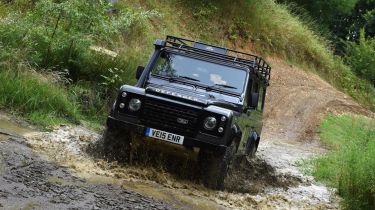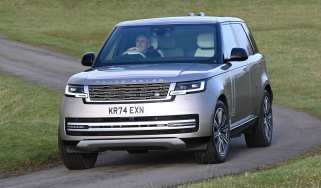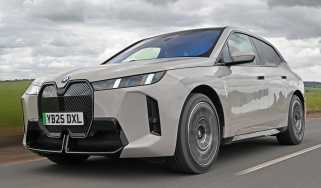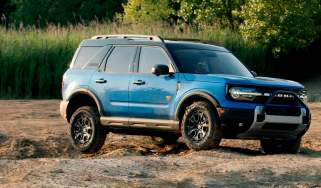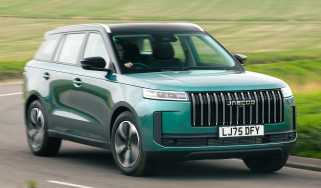Used Land Rover Defender (Mk1, 1990-2016) review - How practical is it?
It’s not as big inside as you’d expect and it’s sparsely equipped, but the Defender can turn its hand to anything
Given its size, the Defender is more cramped on the inside than you’d think, although the 110 can carry up to 10. There’s not much standard kit to speak of (a stereo is a luxury), but the hose-down interior is perfect for rugged outdoor pursuits. Speaking of which, few cars are as capable when the weather turns or the going gets rough.
Dimensions and cabin design
Unlike many modern off-roaders, the Land Rover Defender is a no-nonsense looking thing with its boxy shape, sturdy silhouette and wide panel gaps adding to its character.
The two-door, short-wheelbase 90 model is less practical than the four-door, long-wheelbase 110, but the smaller Defender is certainly the better looking of the two. That said, at 4,600mm long the 110 can be tricky to slot into tighter parking spaces. Both versions are relatively narrow, however, meaning the Land Rover feels more wieldy on narrow lanes and around town than you’d think.
Step inside the Land Rover Defender, and 'utilitarian' is a polite term to describe its interior. The driving position is cramped (only the seats are adjustable) and you keep bashing your elbow against the driver's door when steering. In terms of interior space and layout, even the Jeep Wrangler is better.
Used - available now

2024 Land Rover
Defender
32,220 milesAutomaticPetrol3.0L
Cash £63,500
2024 Land Rover
Defender
71,173 milesAutomaticDiesel3.0L
Cash £48,562
2024 Land Rover
Defender
21,422 milesAutomaticDiesel3.0L
Cash £64,177
2020 Land Rover
Defender
26,904 milesAutomaticDiesel2.0L
Cash £44,544Thankfully, the dash is simple to use, but that's because there's not much on it. It's all scratchy, hard black plastic, so don't expect any luxuries, but it is durable.
Depending on the model, space in the back is either adequate or cramped. Early cars have a wide bench seat that will accommodate three adults but offers very little legroom. Later cars have two separate seats, which in the 90 means it’s a strict four seater - although this layout does mean a little more space.
The longer 110 versions have a further pair of removable seats in the boot, making it a seven-seater. Removing them can be a bit of a back-breaking struggle, because they’re quite bulky and heavy.
Pre-2007 cars feature four inward facing seats in the rear, making the 90 up to a seven-seater (with the optional third seat between the driver and passenger), while the 110 is capable of carrying up to 10 occupants. This makes these models more versatile, but the downside is this layout is far less safe as the back seats only feature lap belts
Boot space
Depending on the age of the car you’re looking at, boot capacity is either generous or pretty much non-existent. Later 90 models with the forward facing rear seats have very little space in the back, unless you remove the chairs. If you need to carry things in the boot and at least five people, then the 110 is a far better bet because there are up to 1,600 litres of space to play with (a similar figure to the 90 when those rear seats have been wrestled out).
However, bear in mind that the side opening rear door makes access tricky in tight spots, while the opening itself isn’t that big. There’s also no load cover, so whatever you put in there will be on display for prying eyes.
Equipment and technology
Infotainment is in rather short supply in most Defenders, with most cars limited to a simple CD (or even a cassette player on early cars) and radio unit that plays through a pair of speakers at the front. Even on the latest cars, aftermarket units were fitted by the factory, and while some had Bluetooth connectivity the amount of noise a Land Rover makes on the move means hands-free calls are very shouty affairs.
Elsewhere you get the basics with a Defender, with the standard kit list on earlier cars running to no more than power steering and a simple heating and ventilation system. Post 2007 cars get a smarter dashboard, while desirable XS models feature electric front windows and, on most versions, air-conditioning.
If you want more, then you’ll have to seek out the last limited-edition models, such as the Defender X-Tech. This gets a chunky bodykit, plus special-edition alloy wheels and a range of colours. On the inside, it also featured air-conditioning, a heated windscreen and electric windows.
The best models of all were the trio of special editions Land Rover sold to celebrate the end of
Defender production. The Heritage, Autobiography and Adventure models were built in limited numbers, and had three distinct characters. The Heritage was coloured pale green and had beige cloth trim, in reference to the very first Defender, known affectionately as Huey.
Safety
The car doesn't even feature airbags or stability control, but ABS and traction control were available on higher-spec models. In the Defender's defence, its solid chassis construction means it could take a whack or 10 and still keep going. And don’t go looking for a Euro NCAP rating, because there isn’t one.
